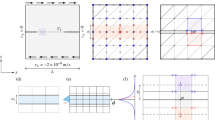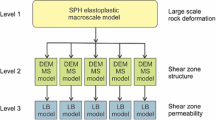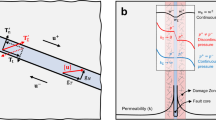Abstract
We utilize smoothed particle hydrodynamics (SPH), a Lagrangian particle-based continuum method, to study the initiation and propagation of shear bands or faults in geologic materials over large deformations. We show that SPH is able to capture the formation of shear bands naturally without needing to introduce a heterogeneity or “seed.” In an actively or passively loaded backfill behind a moving retaining wall, we show that shear bands crossing the surface are inclined at an orientation given by the Arthur angle, \(\varTheta _{\mathrm{A}}=45^{\circ } \pm (\psi +\phi )/4\), with respect to the principal stresses. Additionally, we conduct simulations to explore the fault propagation problem, where a blind fault in rigid basement rock propagates through an overlying weak layer to reach the surface. Our results demonstrate that the resulting shear band rotates as the blind fault progressively accumulates more slip, initially taking the orientation given by the Roscoe angle, \(\varTheta _{\mathrm{R}}=45^{\circ } \pm \psi /2\), then that of the Arthur angle, and lastly, that of the familiar Coulomb orientation, \(\varTheta _{\mathrm{C}}=45^{\circ } \pm \phi /2\), in both extensional and contractional setups. Finally, we also evaluate the validity of empirical solutions describing the shear band propagation path and consider the effect of different material parameters on the geometry of the resultant shear bands, as well as on displacement and deformation at the surface. Our results show that SPH deals well with external loadings such as those applied by a retaining wall, or those induced by tectonic movement like in the fault propagation problem.

















Similar content being viewed by others
References
Adami, S., Hu, X.Y., Adams, N.A.: A generalized wall boundary condition for smoothed particle hydrodynamics. Journal of Computational Physics 231, 7057–7075 (2012)
Adami, S., Hu, X.Y., Adams, N.A.: A transport-velocity formulation for smoothed particle hydrodynamics. Journal of Computational Physics 241, 292–307 (2013)
Allmendinger, R.W., Shaw, J.: Estimation of fault propagation distance from fold shape: Implications for earthquake hazard assessment. Geology 28(12), 1099–1102 (2000)
Anastasopoulos, I. Gazetas, G.: Foundation-structure systems over a rupturing normal fault: Part II Analysis of the Kocaeli case histories. Bulletin of Earthquake Engineering 5, 277–301 (2007)
Anastasopoulos, I., Gazetas, G.: Analysis of cut-and-cover tunnels against large tectonic deformation. Bulletin of Earthquake Engineering 8, 283–307 (2010)
Anastasopoulos, I., Gazetas, G., Bransby, M.F., Davies, M.C.R., Nahas, A.E.: Fault rupture propagation through sand: Finite-element analysis and validation through centrifuge experiments. Journal of Geotechnical and Geoenvironmental Engineering 133(8), 943–958 (2007)
Arthur, J.R.F., Dunstan, T., Al-Ani, Q.A.J.L., Assadi, A.: Plastic deformation and failure in granular media. Géotechnique 27(1), 53–74 (1977)
Baziar, M.H., Nabizadeh, A., Lee, C.J., Hung, W.Y.: Centrifuge modeling of interaction between reverse faulting and tunnel. Soil Dynamics and Earthquake Engineering 65, 151–164 (2014)
Belytschko, T., Black, T.: Elastic crack growth in finite elements with minimal remeshing. International Journal for Numerical Methods in Engineering 45, 601–620 (1999)
Bonet, J., Lok, T.S.: Variational and momentum preservation aspects of smooth particle hydrodynamics formulations. Computer Methods in Applied Mechanics and Engineering 180(1–2), 97–115 (1999)
Borja, R.I.: A finite element model for strain localization analysis of strongly discontinuous fields based on standard Galerkin approximation. Computer Methods in Applied Mechanics and Engineering 190(11–12), 1529–1549 (2000)
Borja, R.I.: Bifurcation of elastoplastic solids to shear band mode at finite strain. Computer Methods in Applied Mechanics and Engineering 191(46), 5287–5314 (2002)
Borja, R.I.: Computational modeling of deformation bands in granular media, II: Numerical simulations. Computer Methods in Applied Mechanics and Engineering 193(27–29), 2699–2718 (2004)
Borja, R.I.: Plasticity Modeling & Computation. Springer, Berlin (2013)
Borja, R.I., Aydin, A.: Computational modeling of deformation bands in granular media, I: Geological and mathematical framework. Computer Methods in Applied Mechanics and Engineering 193(27–29), 2667–2698 (2004)
Borja, R.I., Lai, T.Y.: Propagation of localization instability under active and passive loading. Journal of Geotechnical and Geoenvironmental Engineering 128(1), 64–75 (2002)
Borja, R.I., Song, X., Rechenmacher, A.L., Abedi, S., Wu, W.: Shear band in sand with spatially varying density. Journal of the Mechanics and Physics of Solids 61(1), 219–234 (2013)
Borja, R.I., Song, X., Wu, W.: Critical state plasticity Part VII: Triggering a shear band in variably saturated porous media. Computer Methods in Applied Mechanics and Engineering 261-262, 66–82 (2013)
Borja, R.I., Yin, Q., Zhao, Y.: Cam-Clay plasticity Part IX: On the anisotropy, heterogeneity, and viscoplasticity of shale. Computer Methods in Applied Mechanics and Engineering 360, 112 (2020)
Bransby, M.F., Davies, M.C.R., Nahas, A.E.: Centrifuge modeling of normal fault-foundation interaction. Bulletin of Earthquake Engineering 6, 585–605 (2008)
Bransby, M.F., Davies, M.C.R., Nahas, A.E., Nagaoka, S.: Centrifuge modeling of reverse fault-foundation interaction. Bulletin of Earthquake Engineering 6, 607–628 (2008)
Bui, H.H., Fukagawa, R.: An improved SPH method for saturated soils and its application to investigate the mechanisms of embankment failure: Case of hydrostatic pore-water pressure. International Journal for Numerical and Analytical Methods in Geomechanics 37, 31–50 (2013)
Bui, H.H., Fukagawa, R., Sako, K., Ohno, S.: Lagrangian meshfree particles method (SPH) for large deformation and failure flows of geomaterial using elastic-plastic soil constitutive model. International Journal for Numerical and Analytical Methods in Geomechanics 32, 1537–1570 (2008)
Bui, H.H., Fukagawa, R., Sako, K., Wells, J.C.: Slope stability analysis and discontinuous slope failure simulation by elasto-plastic smoothed particle hydrodynamics (SPH). Géotechnique 61(7), 565–574 (2011)
Caquot, A., Kerisel, J.: Tables for the Calculation of Passive Pressure, Active Pressure and Bearing Capacity of Foundations. Gauthier-Villars, Paris (1948)
Colagrossi, A., Bouscasse, B., Antuono, M., Marrone, S.: Particle packing algorithm for SPH schemes. Computer Physics Communications 183(8), 1641–1653 (2012)
Cole, D.A., Lade, P.V.: Influence zones in alluvium over dip-slip faults. Journal of Geotechnical Engineering 110(5), 599–615 (1984)
Coulomb, C.A.: Essai sur une application des regles des maximis et minimis a quelques problemes de statique relatifs a l’architecture. Memoires de l’Academie Royale pres Divers Savants 7 (1776)
Design Manual: 7.02: foundations and earth structures: naval facilities engineering command (1986)
Desrues, J., Argilaga, A., Caillerie, D., Combe, G., Nguyen, T.K., Richefeu, V., Pont, S.: From discrete to continuum modelling of boundary value problems in geomechanics: An integrated FEM-DEM approach. International Journal for Numerical and Analytical Methods in Geomechanics 43(5), 919–955 (2019)
Egholm, D.L., Sandiford, M., Clausen, O.R., Nielsen, S.B.: A new strategy for discrete element numerical models: 2. Sandbox applications. Journal of Geophysical Research 112, B05204 (2007)
Erslev, E.: Trishear fault-propagation folding. Geology 19(6), 617–620 (1991)
Fávero Neto, A.H.: A continuum Lagrangian finite deformation computational framework for modeling granular flows. Ph.D. thesis, Stanford University (2020)
Fávero Neto, A.H., Askarinejad, A., Springman, S.M., Borja, R.I.: Simulation of debris flow on an instrumented test slope using an updated Lagrangian particle method. Acta Geotechnica 15, 2757–2777 (2020)
Fávero Neto, A.H., Borja, R.I.: Continuum hydrodynamics of dry granular flows employing multiplicative elastoplasticity. Acta Geotechnica 13(5), 1027–1040 (2018)
Finch, E., Hardy, S., Gawthorpe, R.: Discrete element modelling of contractional fault-propagation folding above rigid basement fault blocks. Journal of Structural Geology 25(4), 518–528 (2003)
Finch, E., Hardy, S., Gawthorpe, R.: Discrete-element modelling of extensional fault-propagation folding above rigid basement fault blocks. Basin Research 16, 489–506 (2004)
Garcia, F.E., Bray, J.D.: Distinct element simulations of shear rupture in dilatant granular media. International Journal of Geomechanics 18(9), 04018111 (2018)
Gingold, R., Monaghan, J.: Smoothed particle hydrodynamics: theory and application to nonspherical stars. Monthly Notices of the Royal Astronomical Society 181, 375–389 (1977)
Gomez-Gesteira, M., Rogers, B.D., Dalrymple, R.A., Crespo, A.J.: State-of-the-art of classical SPH for free-surface flows. Journal of Hydraulic Research 48(sup1), 6–27 (2010)
Gray, J., Monaghan, J., Swift, R.: SPH elastic dynamics. Computer Methods in Applied Mechanics and Engineering 190(49–50), 6641–6662 (2001)
Hardy, S.: Propagation of blind normal faults to the surface in basaltic sequences: Insights from 2D discrete element modelling. Marine and Petroleum Geology 48, 149–159 (2013)
Hardy, S.: Discrete element modelling of extensional, growth, fault-propagation folds. Basin Research 31, 584–599 (2018)
Hardy, S., Finch, E.: Mechanical stratigraphy and the transition from trishear to kink-band fault-propagation fold forms above blind basement thrust faults: A discrete-element study. Marine and Petroleum Geology 24(2), 75–90 (2007)
Hazeghian, M., Soroush, A.: DEM simulation of reverse faulting through sands with the aid of GPU computing. Computers and Geotechnics 66, 253–263 (2015)
Hazeghian, M., Soroush, A.: DEM-aided study of shear band formation in dip-slip faulting through granular soils. Computers and Geotechnics 71, 221–236 (2016)
Hu, Y., Randolph, M.: A practical numerical approach for large deformation problems in soil. International Journal for Numerical and Analytical Methods in Geomechanics 22(5), 327–350 (1998)
Hughes, T., Winget, J.: Finite rotation effects in numerical integration of rate constitutive equations arising in large-deformation analysis. International Journal for Numerical Methods in Engineering 15(12), 1862–1867 (1980)
Jin, Y.F., Yuan, W.H., Yin, Z.Y., Cheng, Y.M.: An edge-based strain smoothing particle finite element method for large deformation problems in geotechnical engineering. International Journal for Numerical and Analytical Methods in Geomechanics 44(7), 923–941 (2020)
Kermani, E., Qiu, T.: Simulation of quasi-static axisymmetric collapse of granular columns using smoothed particle hydrodynamics and discrete element methods. Acta Geotechnica 15, 423–437 (2020)
Lade, P.V., Cole, D.A., Cummings, D.: Multiple failure surfaces over dip-slip faults. Journal of Geotechnical Engineering 110(5), 616–627 (1984)
Li, X., Konietzky, H., Li, X., Wang, Y.: Failure pattern of brittle rock governed by initial microcrack characteristics. Acta Geotechnica 14, 1437–1457 (2019)
Liang, W., Zhao, J.: Multiscale modeling of large deformation in geomechanics. International Journal for Numerical and Analytical Methods in Geomechanics 43(5), 1080–1114 (2019)
Liu, F.: Modeling hydraulic fracture propagation in permeable media with an embedded strong discontinuity approach. International Journal for Numerical and Analytical Methods in Geomechanics 44(12), 1634–1655 (2020)
Liu, F., Borja, R.I.: A contact algorithm for frictional crack propagation with the extended finite element method. International Journal for Numerical and Analytical Methods in Geomechanics 76, 1489–1512 (2008)
Liu, F., Borja, R.I.: Stabilized low-order finite elements for frictional contact with the extended finite element method. Computer Methods in Applied Mechanics and Engineering 199(37–40), 2456–2471 (2010)
Liu, F., Borja, R.I.: Extended finite element framework for fault rupture dynamics including bulk plasticity. International Journal for Numerical and Analytical Methods in Geomechanics 37(18), 3087–3111 (2013)
Liu, G.R., Liu, M.B.: Smoothed Particle Hydrodynamics: A meshfree particle method. World Scientific, Singapore (2003)
Loukidis, D., Bouckovalas, G.D., Papadimitriou, A.G.: Analysis of fault rupture propagation through uniform soil cover. Soil Dynamics and Earthquake Engineering 29(11–12), 1389–1404 (2009)
Lucy, L.B.: A numerical approach to the testing of the fission hypothesis. The Astronomical Journal 82(12):1013–1024 (1977)
Ma, G., Regueiro, R., Zhou, W., Liu, J.: Spatiotemporal analysis of strain localization in dense granular materials. Acta Geotechnica 14, 973–990 (2019)
Mitra, S., Mount, V.: Foreland basement-involved structures. American Association of Petroleum Geologists Bulletin 82(1), 70–109 (1998)
Nguyen, N.H.T., Bui, H.H., Nguyen, G.D.: An approach to calculating large strain accumulation for discrete element simulations of granular media. International Journal for Numerical and Analytical Methods in Geomechanics 44(11), 1525–1547 (2020)
Nitka, M., Tejchman, J., Kozicki, J., Leśniewska, D.: DEM analysis of micro-structural events within granular shear zones under passive earth pressure conditions. Granular Matter 17, 325–343 (2015)
Nollet, S., Vennekate, G.J.K., Giese, S., Vrolijk, P., Urai, J.L., Ziegler, M.: Localization patterns in sandbox-scale numerical experiments above a normal fault in basement. Journal of Structural Geology 39, 199–209 (2012)
Patton, T.L., Fletcher, R.C.: Mathematical block-motion model for deformation of a layer above a buried fault of arbitrary dip and sense of dip. Journal of Structural Geology 17(10), 1455–1472 (1995)
Peng, C., Guo, X., Wu, W., Wang, Y.: Unified modelling of granular media with Smoothed Particle Hydrodynamics. Acta Geotechnica 11, 1231–1247 (2016)
Peng, C., Wang, S., Wu, W., Yu, H., Wang, C., Chen, J.Y.: LOQUAT: an open-source GPU-accelerated SPH solver for geotechnical modeling. Acta Geotechnica 14, 1269–1287 (2019)
Peng, C., Wu, W., Yu, H.S.Y., Wang, C.: A SPH approach for large deformation analysis with hypoplastic constitutive model. Acta Geotechnica 10, 703–717 (2015)
Pollard, D.D., Fletcher, R..:C Fundamentals of Structural Geology. Cambridge University Press, Cambridge (2005)
Pollard, D.D., Martel, S.J.: Structural geology (a quantitative introduction). Cambridge University Press, Cambridge (2020)
Ramachandran, P., Bhosale, A., Puri, K., Negi, P., Muta, A., Dinesh, A., Menon, D., Govind, R., Sanka, S., Sebastian, A.S., Sen, A., Kaushik, R., Kumar, A., Kurapati, V., Patil, M., Tavker, D., Pandey, P., Kaushik, C., Dut,t A., Agarwal, A.: PySPH: a Python-based framework for smoothed particle hydrodynamics (2020)
Randles, P., Libersky, L.: Smoothed Particle Hydrodynamics: Some recent improvements and applications. Computer Methods in Applied Mechanics and Engineering 139(14):375–408 (1996)
Rankine, W.J.M.: On the stability of loose earth. Philosophical Transactions of the Royal Society London 147(1), 9–27 (1857)
Reches, Z., Eidelman, A.: Drag along faults. Tectonophysics 247(1–4), 145–156 (1995)
Rockfield: Eflen explicit manual. Rockfield Software, Swansea, UK, (version 4.10) edn (2017)
Roscoe, K.H.: The influence of strains in soil mechanics. Géotechnique 20(2), 129–170 (1970)
Rudnicki, J.W., Rice, J.R.: Conditions for the localization of deformation in pressure-sensitive dilatant materials. Journal of the Mechanics and Physics of Solids 23(6), 371–394 (1975)
Saltzer, S.D., Pollard, D.D.: Distinct element modeling of structures formed in sedimentary overburden by extensional reactivation of basement normal faults. Tectonics 11(1), 165–174 (1992)
Sanz, P.F., Borja, R.I., Pollard, D.D.: Mechanical aspects of thrust faulting driven by far-field compression and their implications for fold geometry. Acta Geotechnica 2, 17–31 (2007)
Semnani, S.J., White, J.A., Borja, R.I.: Thermoplasticity and strain localization in transversely isotropic materials based on anisotropic critical state plasticity. International Journal for Numerical and Analytical Methods in Geomechanics 40(18), 2423–2449 (2016)
Shaw, J.H., Shearer, P.M.: An elusive blind-thrust fault beneath metropolitan Los Angeles. Science 283(5407), 1516–1518 (1999)
Song, X., Borja, R.I.: Finite deformation and fluid flow in unsaturated soils with random heterogeneity. Vadose Zone Journal 13(5):1–11 (2014)
Song, X., Borja, R.I.: Mathematical framework for unsaturated flow in the finite deformation range. International Journal for Numerical Methods in Engineering 14(9), 658–682 (2014)
Suppe, J.: Principles of Structural Geology. Prentice-Hall, Hoboken (1984)
Suppe, J., Medwedeff, D.A.: Geometry and kinematics of fault-propagation folding. Eclogae Geologicae Helvetiae 83(3), 409–454 (1990)
Thebian, L., Najjar, S., Sadek, S., Mabsout, M.: Numerical investigation of dip-slip fault propagation effects on offshore seabed sediments. Engineering Geology 237, 149–167 (2018)
Tran, H.T., Wang, Y., Nguyen, G.D., Kodikara, J., Sanchez, M., Bui, H.H.: Modelling 3D desiccation cracking in clayey soils using a size-dependent SPH computational approach. Computers and Geotechnics 116, 103209 (2019)
Vardoulakis, I., Goldscheider, M., Gudehus, G.: Formation of shear bands in sand bodies as a bifurcation problem. International Journal for Numerical and Analytical Methods in Geomechanics 2(2), 99–128 (1978)
Vignjevic, R., Djordjevic, N., Gemkow, S., De Vuyst, T., Campbell, J.: SPH as a nonlocal regularisation method: Solution for instabilities due to strain-softening. Computer Methods in Applied Mechanics and Engineering 277, 281–304 (2014)
Violeau, D.: Fluid Mechanics and the SPH Method. Oxford University Press, Oxford (2012)
Wang, G., Riaz, A., Balachandran, B.: Smooth particle hydrodynamics studies of wet granular column collapses. Acta Geotechnica 15, 1205–1217 (2020)
Wang, H.N., Jiang, M.J., Zhao, T., Zeng, G.S.: Viscoelastic solutions for stresses and displacements around non-circular tunnels sequentially excavated at great depths. Acta Geotechnica 14, 111–139 (2019)
Wang, Y., Bui, H.H., Nguyen, G.D., Ranjith, P.G.: A new SPH-based continuum framework with an embedded fracture process zone for modelling rock fracture. International Journal of Solids and Structures 159, 40–57 (2019)
Wang, Y., Tran, H.T., Nguyen, G.D., Ranjith, P.G., Bui, H.H.: Simulation of mixed-mode fracture using SPH particles with an embedded fracture process zone. International Journal for Numerical and Analytical Methods in Geomechanics 44(10), 1417–1445 (2020)
Wendland, H.: Piecewise polynomial, positive definite and compactly supported radial functions of minimal degree. Advances in Computational Mathematics 4(1), 389–296 (1995)
Widuliński, Ł., Tejchman, J., Kozicki, J., Leśniewska, D.: Discrete simulations of shear zone patterning in sand in earth pressure problems of a retaining wall. International Journal of Solids and Structures 48(7–8), 1191–1209 (2011)
Wolfe, F.D., Shaw, J.H., Plesch, A., Ponti, D.J., Dolan, J.F., Legg, M.R.: The Wilmington blind-thrust fault: An active concealed earthquake source beneath Los Angeles, California. Bulletin of the Seismological Society of America 109(5), 1890–1906 (2019)
Xu, G., Gutierrez, M., He, C., Meng, W.: Discrete element modeling of transversely isotropic rocks with non-continuous planar fabrics under Brazilian test. Acta Geotechnica 15, 2277–2304 (2020)
Xu, W.J., Liu, G.Y., Yang, H.: Study on the mechanical behavior of sands using 3D discrete element method with realistic particle models. Acta Geotechnica 15, 2813–2828 (2020)
Zhan, L., Peng, C., Zhang, B., Wu, W.: A SPH framework for dynamic interaction between soil and rigid body system with hybrid contact method. International Journal for Numerical and Analytical Methods in Geomechanics 44(10), 1446–1471 (2020)
Zhao, S., Bui, H.H., Lemiale, V., Nguyen, G.D., Darve, F.: A generic approach to modelling flexible confined boundary conditions in SPH and its application. International Journal for Numerical and Analytical Methods in Geomechanics 43(5), 1005–1031 (2019)
Zhao, T., Liu, Y.: A novel random discrete element analysis of rock fragmentation. International Journal for Numerical and Analytical Methods in Geomechanics 44(10), 1386–1395 (2020)
Zhao, Y., Borja, R.I.: A continuum framework for coupled solid deformation-fluid flow through anisotropic elastoplastic porous media. Computer Methods in Applied Mechanics and Engineering 369, 113225 (2020)
Zhao, Y., Semnani, S.J., Yin, Q., Borja, R.I.: On the strength of transversely isotropic rocks. International Journal for Numerical and Analytical Methods in Geomechanics 42(16), 1917–1934 (2018)
Acknowledgements
This material is based upon work supported by the US Department of Energy, Office of Science, Office of Basic Energy Sciences, Geosciences Research Program, under Award Number DE-FG02-03ER15454. Support for materials and additional student hours were provided by the National Science Foundation under Award Number CMMI-1914780. The first author acknowledges the support by the US National Science Foundation (NSF) Graduate Research Fellowship under Grant DGE 1656518, as well as by the Stanford Graduate Fellowship.
Author information
Authors and Affiliations
Corresponding author
Additional information
Publisher's Note
Springer Nature remains neutral with regard to jurisdictional claims in published maps and institutional affiliations.
Rights and permissions
About this article
Cite this article
del Castillo, E.M., Fávero Neto, A.H. & Borja, R.I. Fault propagation and surface rupture in geologic materials with a meshfree continuum method. Acta Geotech. 16, 2463–2486 (2021). https://doi.org/10.1007/s11440-021-01233-6
Received:
Accepted:
Published:
Issue Date:
DOI: https://doi.org/10.1007/s11440-021-01233-6




